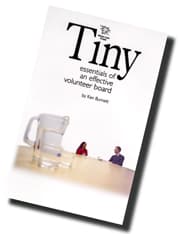How, precisely, do you build a better board? Part 2
Welcome to the second and final part of this listing of what makes an effective non-profit board.
- Written by
- Ken Burnett
- Added
- June 30, 2011
The final 13 from Warren Maxwell’s 21 keys to an effective volunteer board:

9. Get the board’s balance right: introduce formal terms of service, retirement policy, gender balance, age, representation from the field, regions, retaining institutional memory, etc.
His experiences of visiting other boards clearly showed Warren the importance of achieving a balanced board, not just in terms of its physical composition in background and demographics but also in its personality, its skills sets, and even its interests and attitudes.
The achievement of appropriate balance is an ongoing challenge, a work that is never quite complete.
While diversity and balance are great board strengths, of course in some areas the board has to be united, consistent and absolutely of one mind. This includes their commitment to the mission and aims of their organisation, their vision of the future for their organisation and their belief in and commitment to the job they all do, collectively, as the board of trustees.

10. Establish a board development committee (or group) to continuously recruit the right skills and experience for a skilled, balanced and representative board.. Its roles include identifying and recruiting trustees, induction, development and goal-setting. Produce an excellent board recruitment pack.
Develop a skills matrix and retirement schedule. Train the chair and CEO in recruitment skills.
No trustee should feel he or she has a job for life. If your board opts for a regular turnover of trustees – most opt for either two or three three-year periods followed by at least one ‘fallow’ year off the board – then it’ll need a regular programme of identification and recruitment of suitable candidates. This is a huge and very important task, best undertaken by a small sub-group of competent and hard-working trustees and senior managers who can make sure that sufficient candidates of the right calibre and personality are brought forward and effectively screened, appointed and developed.
Your own judgement will tell you what should go in the board recruitment pack, but while including all the essentials (such as the trustees’ handbook and the annual report) its best to keep it short, focussed and interesting.
11. Offer regular development opportunities for board members so that they can grow in their roles, increase the value of their contribution and avoid becoming stale. Implement a regular induction programme for new trustees, which established members can join too, for refreshment and renewal.
Many organisations combine the development role with induction, so that immersion in the work of their nonprofit is an ongoing process for board members.
Make induction fun as well as instructive. But respect the time your volunteers are giving up for this. So make it effective, informative and enjoyable.
12. Run good, enjoyable and informative meetings. Make sure they start and end on time.
Being a trustee is far from all about meetings, but the meetings can be the focal point for board members and it’s important that they be as good and as effective as possible.
13. Communicate effectively: between meetings, to staff, to the outside but mostly, to the board, to let them know any important happenings
Little and often is probably a good rule here, but use your knowledge of each individual trustee to ensure it’s the right amount and not too frequent or too scarce.
14. Practice openness and accountability. Publish your governance procedures and outcomes widely.
Publish the board’s minutes of meetings to all stakeholders, edited only for the genuinely confidential. Allowing other staff and visitors to attend board meetings and to present to board meetings will spread unity and dispel mystery. Don’t usher visitors out immediately, once they’ve completed their part of the agenda. Let the world see what your board does and how it functions. They’ll almost certainly be impressed, and reassured.
Put your trustees’ handbook on your website and offer it in your annual report.
15. Establish procedures for managing tasks/committees
All boards have sub-committees it seems and although some are essential to the smooth running of the board, many have more than they need. It’s often a better idea to form a working group with a fixed task and deadline rather than a committee whose existence is enshrined into perpetuity. Whatever committee functions are right for your board, it is crucial to avoid the possibility of any committee expropriating the essential functions of the whole board. No committee should be able to make any trustee feel excluded from what he or she needs to properly discharge their responsibilities as a trustee.
16. Ensure that when board members work for the organisation in addition to their trustee role, both inside and outside the board, that they do so as respected volunteers, not revered and unchallengeable trustees.
Too often trustees become an elite power, which can be very disruptive particularly to staff. The best way round this is to ensure that they have dual status as both board member and volunteer. Then to gently deflate any notions of superiority that may surround the role of board member.
In most cultures it is the board collectively that is the legal entity and has the clearly defined role and responsibility, rather than its individual members. It is useful to stress to board members that they work for and support the organisation collectively in a statutory role, but individually in an advisory role.
17. Conduct regular formal board assessment
Just like any other part of the organisation, the board of trustees has to be assessed regularly, openly and professionally. As each board is different this can take many forms and be as structured or informal as seems appropriate. (A sample structure for a board evaluation can be found on the publisher’s website, www.whitelionpress.com).
18. Organise board retreats regularly (this can be dispensed with if your board meetings involve an overnight stay for all trustees).
Their value is in the social interactions between board members. This is where bonds are formed and team spirit is built.
19. Have strategies for dealing with difficult board members
All boards suffer from this some time or other. There will inevitably be one or more difficult members who will disrupt the team and cause rather than resolve problems. The key is not to try to ignore them in the hope that they will go away. Almost invariably, they won’t. Boards – or perhaps more commonly, board chairs – need to be firm, clear and fair with trustees who are not performing as agreed, including both those who don’t turn up at meetings and those who persistently try to hog the limelight. Obviously failing trustees should be quickly removed so as to create space for another who will contribute.

20. Retain a sense of humour, celebrate successes and have fun.
It’s been said that humour isn’t an absolute essential, but many experienced trustees disagree. No board will function as well as it might without the enjoyment of a balanced amount of humour and an appropriate dose of fun. This isn’t a tiny thing either – it’s rather fundamental.
Yet some boards take themselves so seriously that being with them is almost like being in church; their meetings are like services and when the chair speaks it seems he’s making a speech or delivering a sermon. Long faces and solemnity don’t facilitate good decisions nor lead to inspirational ideas or good governance. Boards need to be serious, of course, but not taking oneself too seriously is just as important as being serious enough. An enjoyable, light atmosphere can mitigate any excesses. It’s worth making provision for it.
And it goes without saying that trustees should visibly celebrate their own and their organisations’ successes – while not putting themselves centre stage, of course.
21. Share your experience and knowledge freely with other boards and trustees.
One of the greatest assets of the nonprofit sector is the openness and spirit of freely sharing information, experience and results that characterises voluntary organisations. While taking full advantage of this, trustees should in turn commit themselves and their organisations to open and generous sharing with others.
With these 21 points in mind it nevertheless repays prospective trustees, particularly would-be chairs of trustees, to visit and study other boards both good and bad, to see what their board might aspire to, and what it should avoid.
© Ken Burnett 2008
All images courtesy of The White Lion Press. This article is abridged from their book Tiny Essentials of an Effective Volunteer Board. Its author, Ken Burnett, can be reached via www.kenburnett.com.


















